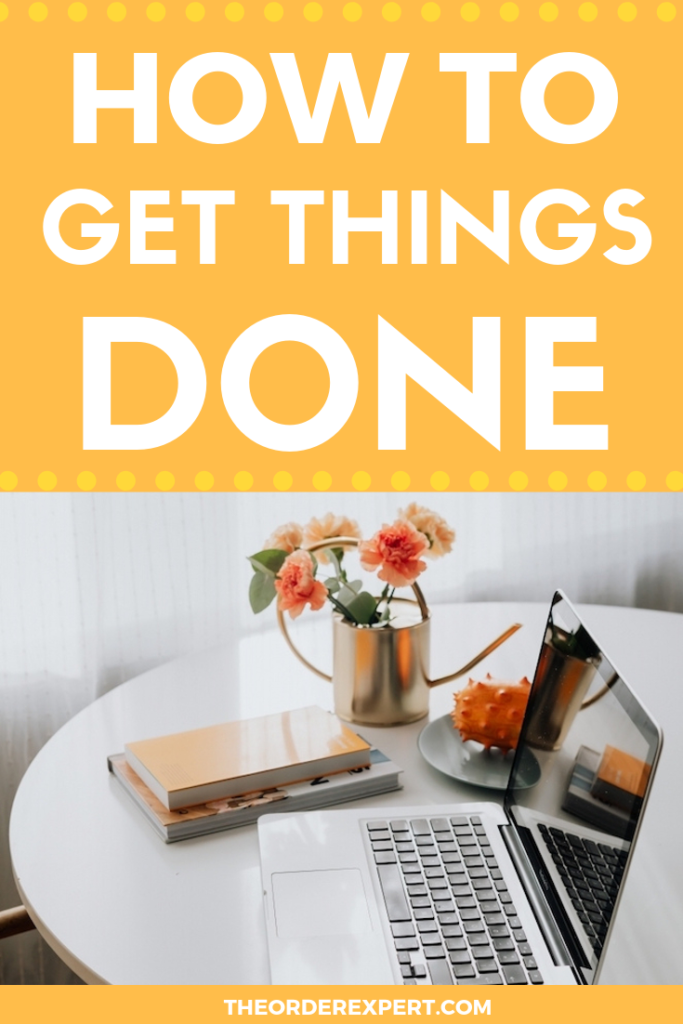
Do you want to get things done at home, work, or school?
Are you tired of not being able to cross tasks off your personal to-do list or make progress in your professional projects?
You may not realize it, but there’s a lot more effort, direction, and timing involved when it comes to getting things done.
It’s all about having a plan, setting boundaries, creating a suitable environment, and you guessed it…doing your work.
In this detailed blog post, I offer an eight-step process on how to get things done.
You can use this process to complete almost any task, errand, to-do, assignment, or project.
Above all, keep this point in mind: if you want to answer the question of how to get things done, remember that you are the key.
You are the one who will make a plan, carve out the time, and put their nose to the grindstone.
You’ve got this! 🙂
Now, let’s move on to the tips…
Make a plan.
Let’s start with the basics: if you want to get things done, you need to have a solid plan in place.
Making vague statements as in, “I’m going to get things done today,” is about as useful as saying, “I’m going to eat some healthy food today.”
The real magic happens when you are 100% clear in your plans, because you know exactly what you need to do in order to reach your goal.
So, instead of saying, “I’m going to eat some healthy food today,” you might turn that into, “I’m going to eat bowlful of oatmeal and a banana for breakfast.” In this case, it’s crystal clear you’d need to prepare some oatmeal and grab a banana from the kitchen.
This same logic applies to your productivity levels.
What’s your plan for today? What do you want to accomplish? Take a moment to write down three to five tasks you’d like to complete today.
Once you’ve captured these tasks on paper, the next step is to revise them into clearly defined tasks. Taking the time to clearly define tasks will make it easier for you to actually complete your work.
Here’s a couple of examples for you:
- “Work on research report” becomes “Proofread research report for typos and grammatical errors”
- “Run errands” becomes “Pick up prescription from drugstore, shop for fruits and vegetables at supermarket, pickup dry cleaning from the cleaner’s”
- “Study for exam” becomes “Work on problem set by myself and study flash cards with a classmate”
Go ahead and break down your tasks into clearly-defined, bite-sized ones. If a single task seems too large to complete in a single sitting, head back to the drawing board. If necessary, you can spread the task out over the course of a few days, or weeks.
Gather the right tools.
When it comes to getting things done, you need to make sure you have the right tools on hand. Think about it for a moment: attempting to hammer a nail into a piece of wood isn’t all that helpful if you’re using a wrench! The right tools will allow you to work quickly and efficiently.
Give yourself a few moments to determine which tools you’ll need for your work. You can jot down tools needed on a piece of scrap paper or simply make a mental note.
If you’re working on a scrapbooking project, you may note you’ll need your scrapbook of choice, along with stamps, ink pads, glitter, glue, photos, and markers. If you’re working on a research paper on your computer, you may make a mental note to pull out your laptop, charger, and mouse.
What’s more, you want to make sure you have the right tools for the job, and not a tool more. Excess tools can slow down your progress, and cause safety issues!
Imagine what it would be like to bake a cake in your kitchen if you had all your outdoor grilling tools set out on your kitchen table or countertop. That’s certainly several tools too many when it comes to baking a simple cake.
Keep to the basics and make sure you have the right tools on hand…and not a tool more.
Schedule time to work.
Yes, this does sound ridiculously simple, but setting aside time to do your work can make or break your chances of getting things done. If you don’t have the time now to do something, when will you do it?
If you’re totally serious about getting things done, you’ll want to specifically set aside time in your calendar. Open up your digital calendar or paper planner and write the days and times you’ll work on tasks.
Don’t cheat and try to double-book yourself. Schedule a task into a single time slot. If you have a non-urgent appointment sitting in time slot, reschedule the existing appointment right away. Make a phone call, send an email or text, and move your existing appointment to a future date.
If you can’t find open spaces of time in your schedule, you’ll need to prioritize your tasks and make some time for yourself. This may mean you’ll have to temporarily pass up one thing for another, such as trading in part of your three-hour of television binge on Tuesday night to work on your scrapbooking, or passing up Thursday’s non-mandatory office meeting to finish proofreading that report.
Still not convinced about setting aside time in your schedule so you can get things done?
Look at it this way: if you don’t make time for yourself, who will?
Say “no” more often than you say “yes.”
If you want to get things done, you absolutely have to learn how to say “no” more often than you say “yes.” On any given day, any number of invitations, events, activities, or requests can innocently pop up, causing both you, and your plans, to go off track.
You need to be the one who sets boundaries in your life. You’re not being impolite or mean, you’re just getting things done…
What happens if you receive a last-minute lunch invite from a friend? Graciously thank them for the offer, and tell them that you’ll take a rain check.
What happens if you receive an invitation for a non-urgent volunteer work project? You’ll have to pass.
And what happens if an optional shift opens up at the community garden? You’re unable to do it.
Now, if you find yourself saying “yes” more often than you’re saying “no,” you’ll need to do some course correction. Focus on what you want to get done.
Remember, when you say “no” to someone else’s invitation, request, or agenda, you are in fact saying “yes” to your own goals, plans, and dreams.
Reduce or eliminate distractions.
When it comes to getting things done, it is imperative that you reduce or eliminate distractions. Distractions will waste your time, zap your energy, and slow down your progress.
All the more reason to nip them in the bud as easily as possible!
Here’s several solutions to common distractions:
Distraction #1. You constantly check email, your cell phone, and social media.
Suggested solutions: Completely log out of email and social media applications, temporarily disable wi-fi connections on your digital device, switch off your digital device, or travel to a location or area with little to no wi-fi connectivity.
Distraction #2. There’s too much noise in your immediate environment.
Suggested solutions: Wear noise cancelling headphones, use a white noise generator, listen to music via headphones, find a different location in which to work, do your work at a quieter or less busy time of day.
Distraction #3. You’re constantly being interrupted or bothered by other people.
Suggested solutions: Tell others you’re working and ask to not be disturbed, find a quiet conference room, office, or library in which to work, hire a babysitter to watch the kids, set your phone to go directly to voicemail.
Distraction #4. Your attention is divided.
Suggested solutions: Put away any and all materials, tools, or devices that don’t relate to your current work, take only your work with you to an empty room or location, calm down your monkey mind and clear it of ideas and thoughts.
Put in the work.
When it comes to getting things done, the simple fact of the matter is that you must do the work you set out to do. Period.
Theoretically speaking, you could make a plan, gather tools, set aside time, say no to invitations, and eliminate distractions, but if you do not put in the work that needs to be done, all of your preparation steps will be in vain.
Here’s a fun example for you. Let’s say you want to take a tropical vacation. You can make a detailed itinerary of your trip, pack your swimsuit, clothes, and toiletries, set aside time to book your flights, hotel, and transportation, and say “no” to upcoming parties and events.
But, if you don’t grab your luggage and tickets, lock up your house, travel to the airport, take your flight, and check-in to your hotel at the appointed day and time…guess what? You won’t have a vacation! You have to follow through and complete the work that is required of you in order to take a vacation.
In short, you absolutely have to put in the work. There really is no way around it.
Open the refrigerator and start chopping up vegetables for dinner, and sit at your desk and write a draft chapter of your book.
Gather your personal belongings and car keys and hop in your car to do those errands, and pull on those workout clothes and sneakers and go out for your run.
Put in the work!
Review your progress.
You’ve just finished your work. Before you move onto your next task or project, take a handful of minutes to review what worked, and what didn’t.
This is a great opportunity to review your progress and learn from your experiences.
Here’s a few things you can look at and evaluate with a critical eye:
Review your plan.
Was your plan spot on, extremely ambitious, or was it painfully easy? Knowing what you know now, what changes would you make to your plan if you had to do it all over again?
Review your tools.
Did you have the right tools for your work? If so, what were they? If not, why not? Do any of your tools need to be reviewed, updated, or revised? Make plans to take care of them in the near future.
Review work time.
Did you set aside enough time to do your work? If not, do you need to set aside more time? If so, how much more time? Is it a few more minutes for a few more hours?
Review your track record of saying “no.”
Did you say “no” more often than you said yes? If so, why? Who were you trying to please? Why? What was your goal in saying “yes” to them, and not your work? You can find a lot of great information here if you’re willing to dig deep and look at the source of your motivations.
Review any distractions.
Were you distracted as you performed your work? If so, by what? Did you procrastinate? If so, how? Did you take any steps to correct your distractions or procrastination as you worked, or did you just put up with them? What steps could you take now to prevent being distracted or procrastinating on your work in future?
Celebrate your accomplishments.
Learning how to get things done is only part of the process. The good news is that you have to be willing to celebrate a job well done. Otherwise, what’s the point of simply getting things done?
Wholeheartedly celebrate your accomplishments, no matter how small they may seem You did get something done, didn’t you? (organizing five shirts in your closet is better than zero shirts, right?).
Take comfort in and know that all those little accomplishments are a step towards building something great, be it writing a book, painting a house, or losing 20 lbs.
If you consistently cross off just three items from your to-do list, every day, for 30 days, why, you’d have completed 90 tasks in a months’ time! That’s not too shabby, huh?
Track your progress in a work notebook, productivity journal, or paper calendar. Share your accomplishments with loved ones over a meal of coffee break. Or, simply pat yourself on the back for a job well done today.
Remember, you can always pick up where you left off tomorrow!
How about you? Which of these tips resonated the most with you when it comes to getting things done? What steps are you going to take now to make sure you can get things done today? Join the conversation and leave a comment below!






0 Comments